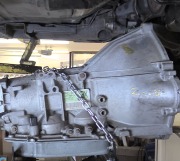P0760 - Shift Solenoid C Malfunction
The Transmission Computer is what detected the defect, set the diagnostic fault code, and put the system into limp mode. Changing the computer doesn't fix the problem. It was doing what is was supposed to do. The fault code directs us to the circuit or system that needs further diagnosis.
Fault codes never say to replace a part or that one is defective, but in this case the solenoid pack is the best suspect. There is a different fault code number when the computer detects an electrical problem related to a shift solenoid. For now, since this code is not an electrical fault code, we can rule out wiring and connector terminal problems related to that solenoid. A better suspect would be that valve is sticking.
You shouldn't have to disconnect the battery. The computer leaves limp mode by simply turning the ignition switch off. If the system goes right back to limp mode as soon as you shift into gear, it is usually caused by an electrical problem. If it goes to limp mode during or right after a shift, usually an up-shift, it is usually caused by worn clutch plates in one of the clutch packs. Less common would be leaking rubber lip seals in those clutch packs. When it goes into limp mode while you're cruising at a steady speed, and no shifts are occurring, the most common cause would be an intermittent electrical problem that just acted up. That's when we'd look for corroded connector terminals, wires rubbed bare and grounding out, and things like that.
While the solenoid pack is the best suspect, a transmission specialist will perform some diagnostic tests first before spending a customer's money on a potentially unneeded part. In this case that would involve pressure tests and reading the stored data that can tell him the amount of life left in those clutch packs.
This system is designed to learn the amount of wear in the clutch packs and adjust the shift overlap to maintain a nice crisp shift. That learning is lost when you disconnect the battery. If you're finding it goes into limp mode less often by disconnecting the battery, compared to just turning the ignition switch off and back on, that might imply the defect is related in some way to that learned data. That could be a valuable clue for the transmission specialist.
Friday, July 31st, 2020 AT 6:58 PM


